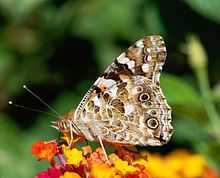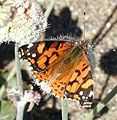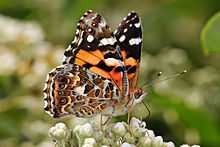Painted lady
| Cynthia (subgenus) | |
|---|---|
 | |
| Vanessa cardui | |
| Scientific classification | |
| Kingdom: | Animalia |
| Phylum: | Arthropoda |
| Class: | Insecta |
| Order: | Lepidoptera |
| Family: | Nymphalidae |
| Subfamily: | Nymphalinae |
| Tribe: | Nymphalini |
| Genus: | Vanessa |
| Subgenus: | Cynthia |
The Cynthia group of colourful butterflies, commonly called painted ladies, comprises a subgenus of the genus Vanessa in the Family Nymphalidae. They are well known throughout most of the world.
The group includes:
- The Painted Lady (Vanessa cardui), which is almost global in its distribution
- Australian Painted Lady (Vanessa kershawi)
- American (Painted) Lady (Vanessa virginiensis)
- West Coast Lady (Vanessa annabella).
Distinguishing features
- For a key to the terms used see Lepidopteran glossary
In general, the Painted Lady is a large butterfly (wing span 5–9 cm (2.0–3.5 in)) identified by the black and white corners of its mainly deep orange, black-spotted wings. It has five white spots in the black forewing tips and while the orange areas may be pale here and there, there are no clean white dots in them. The hindwings carry four small submarginal eyespots on dorsal and ventral sides. Those on the dorsal side are black, but in the summer morph sometimes small blue pupils are present in some. In Europe it migrates annually between North Africa, including Morocco, and northern Europe, using a sun compass for orientation.[1] It was originally thought that the northward movement was a 'Pied Piper' migration, but evidence now exists for an autumn southwards return migration.[2]
The American Painted Lady (V. virginiensis) is most easily distinguishable by its two large hindwing eyespots on the ventral side. virginiensis also features a white dot within the subapical field of the forewings set in pink on the ventral side, and often as a smaller clean white dot in the orange of the dorsal side too. A less reliable indicator is the row of eyespots on the dorsal submarginal hindwing; virginiensis often has two larger outer spots with blue pupils. The black forewing tips have four to five white spots; usually the largest is whitish orange.
The West Coast Lady (V. annabella) does not have obvious ventral eyespots. On the dorsal side, anabella lacks a white dot in the subapical orange found in virginiensis, and is a purer orange color. V. annabella has a fully orange subapical band and leading edge on the forewing. The submarginal row of hindwing spots in annabella features three or four blue pupils. The two larger pupils in annabella are the inner spots, rather than the outer spots as in corresponding virginiensis.
The Australian Painted Lady (V. kershawi) is quite similar to V. cardui. Its four ventral eyespots are less clearly defined, and it always sports at least three (often four) blue pupil spots on its dorsal hindwing. Caterpillars are found mainly on Ammobium alatum.
Lifespan
The lifespan of a Painted Lady Butterfly is 2–4 weeks.
Comparison
-

Vanessa virginiensis
-

Vanessa annabella
-

Vanessa kershawi
References
| Wikimedia Commons has media related to Vanessa cardui. |
- ↑ Nesbit, RL; J.K. Hill, I.P. Woiwod, D. Sivell, K.J. Bensusan, J.W. Chapman (2009). "Seasonally adaptive migratory headings mediated by a sun compass in the painted lady butterfly, Vanessa cardui". Animal Behaviour 78 (5): 1119–1125. doi:10.1016/j.anbehav.2009.07.039.
- ↑ Chapman, Jason W.; Rebecca L. Nesbit; Laura E. Burgin; Don R. Reynolds; Alan D. Smith; Douglas R. Middleton; Jane K. Hill (2010). "Flight orientation behaviors promote optimal migration trajectories in high-flying insects". Science 327 (5966): 682–685. doi:10.1126/science.1182990. PMID 20133570. Retrieved 11 March 2013.
External links
- Painted Lady Butterfly Vanessa cardui : Large format reference quality photographs
- American Painted Lady Butterfly Vanessa virginiensis : Large format reference quality closeup photographs
- Wildlife photos of Painted Lady butterfly
- "Vanessa cardui". Integrated Taxonomic Information System. Retrieved 6 February 2006.
- "Vanessa virginiensis". Integrated Taxonomic Information System. Retrieved 6 February 2006.
